The list below is the most interesting list of all the important Aquatic and Semi-Aquatic Crypitds from around the world. The crazy part about the list is the mystery surrounding these beings.
Either there is not much known, such as photos/videos or a consistant stream of sightings to be certain these things exisit still to this day. I provided a short detailed description of the cryptid’s below. You can do more research if needed on certain types of these animals.
Enjoy the extenstive list below; some of these are just down right creepy. Might want to think twice about swiming in the ocean or lakes. We will do a land-based cryptid list soon.
Altamaha-ha
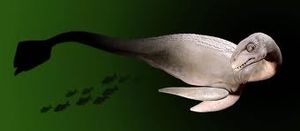
In Georgia folklore, the Altamaha-ha (or Altie) is a legendary creature, alleged to inhabit the myriad small streams and abandoned rice fields near the mouth of the Altamaha River (after which it is named) in southeastern Georgia, United States. Sightings are particularly reported around Darien and elsewhere in McIntosh County.
According to The Brunswick News, the legend has its roots in Muscogee tradition. An alligator gar has been proposed as being a possible identity for recent sightings attributed to the creature. It’s believed to be a Sturgeon or plesiosaur?
Bear Lake Monster
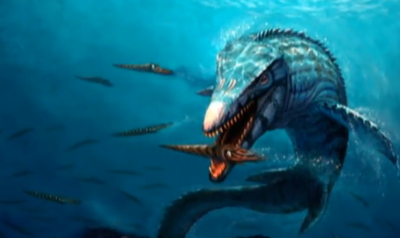
The Bear Lake Monster is a being appearing in folklore near Bear Lake, on the Utah–Idaho border.
The myth originally grew from articles written in the 19th century by Joseph C. Rich, a Mormon colonizer in the area, purporting to report second-hand accounts of sightings of the creature. However, he later recanted the stories.
In recent years the monster is considered to be a tourist attraction. The last reported sighting of the monster was in 2002.
Not all descriptions of the Bear Lake Monster agree, but one team of folklorists stated that it “is reported to resemble a serpent, but with legs about eighteen inches long on which it marauds along the shoreline.” One article reported that the creature had “a large undulating body, with about 30 feet of exposed surface, of a light cream color, moving swiftly through the water, at a distance of three miles from the point of observation.” Its size was reported to be at least fifty feet long, and certainly not less than forty. Some sightings even spoke of a second member of the species and smaller monsters as well.
Bessie
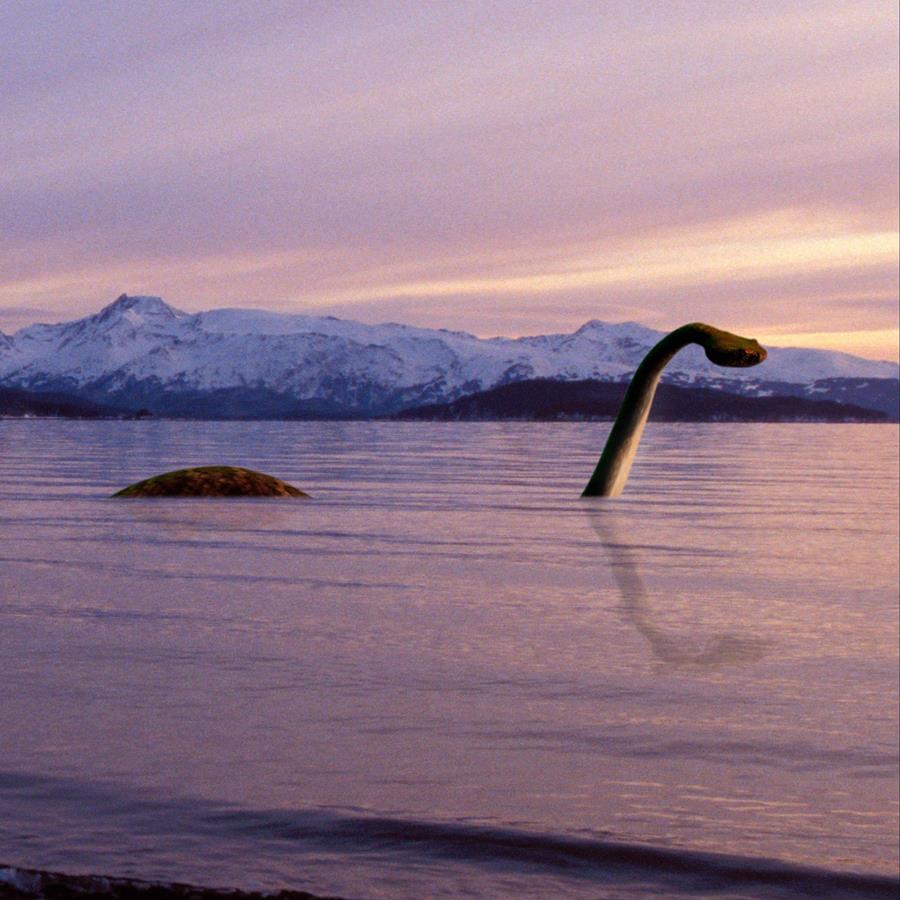
In Michigan folklore, Bessie is a name given to a lake monster in Lake Erie, also known as South Bay Bessie. The first recorded sighting of Bessie occurred in 1793, and more sightings have occurred intermittently and in greater frequency in the last three decades. Bessie is reported to be snake-like and 30 to 40 ft long, at least a foot in diameter, with a grayish color.
While shooting at ducks north of Sandusky, Ohio, in 1793, the captain of the sloop Felicity startled a large creature (snake) described as “more than a rod (16 ½ ft.) in length”
July 1817, the crew of a schooner reported a 30 to 40-foot long serpent, dark in color.
Later that year, another boat crew spotted a similar animal, this time copper-colored and 60 feet in length. This time, they shot at it with muskets, which had no visible effect.
A third 1817 incident took place near Toledo, when French settlers—two brothers named Dusseau—encountered a huge monster on the beach, writhing in what they took to be its death throes.
Brosno Dragon
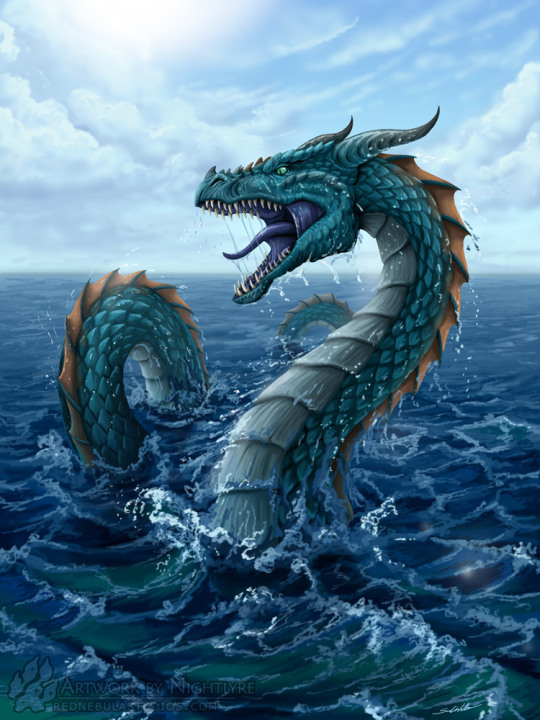
In Russian folklore, Brosno Dragon, also known as Brosnya (Russian: Бросня), is the name given to a lake monster which is said to inhabit Lake Brosno, near Andreapol in West Russia. It is described as resembling a dragon, and is the subject of a number of regional legends, some which are said to date back to the 13th century.
Rumors of a strange, giant creature living in Lake Brosno have existed for several centuries. One legend says that the lake monster scared to death the Tatar-Mongol army that headed for Novgorod in the 13th century. Batu Khan stopped the troops on the sides of Lake Brosno to rest. Horses were allowed to drink water from the lake. However, when the horses ventured down to the lake, a huge roaring creature emerged from the water and started devouring horses and soldiers.
Many people treat the existence of Brosnya skeptically and still say that the creature may be a mutant beaver or a giant pike of 100–150 years. Others conjecture that groups of wild boars and elks cross the lake from time to time.
There are some more scientific hypotheses concerning Brosnya. One of them is a gas version saying that when hydrogen sulfide goes up from the lake bottom it makes water boil up; this boiling in its turn resembles a dragon head. Other version says that there is a volcano in Lake Brosno that makes ejections on the water surface from time to time.
Bunyip
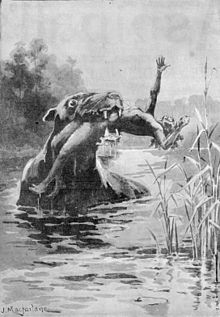
The bunyip is a large mythical creature from Australian Aboriginal mythology, said to lurk in swamps, billabongs, creeks, riverbeds, and waterholes.
The origin of the word bunyip has been traced to the Wemba-Wemba or Wergaia language of Aboriginal people of Victoria, in South-Eastern Australia. The word bunyip is usually translated by Aboriginal Australians today as “devil” or “evil spirit”. But the figure of the bunyip was part of traditional Aboriginal beliefs and stories throughout Australia, while its name varied according to tribal nomenclature. In his 2001 book, writer Robert Holden identified at least nine regional variations of the creature known as the bunyip across Aboriginal Australia. Europeans recorded various written accounts of bunyips in the early and mid-19th century, as they began to settle across the country.
Common features as reported in many 19th-century newspaper accounts include a dog-like face, a crocodile-like head, dark fur, a horse-like tail, flippers, and walrus-like tusks or horns, or a duck-like bill.
Buru
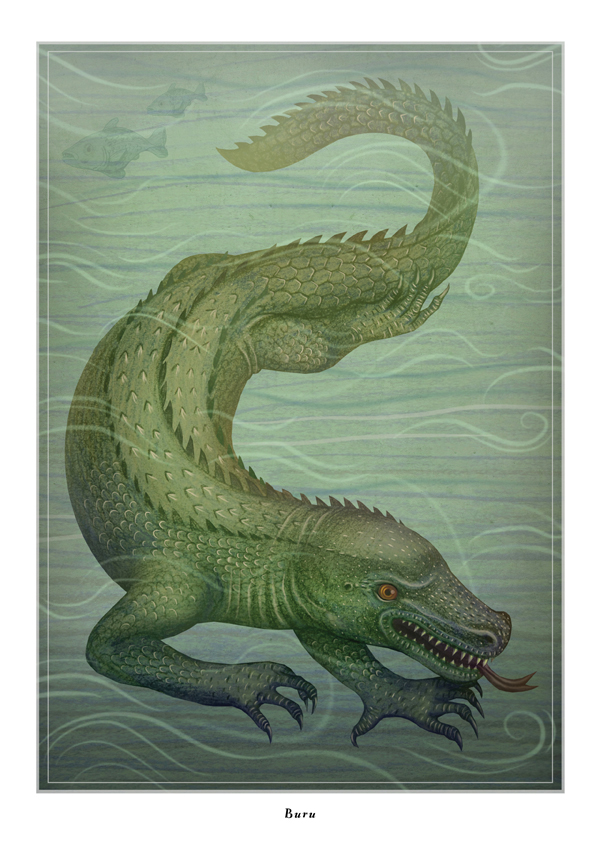
The Buru was an aquatic reptile said to have lived in Ziro valley, a small town in the state of Arunachal Pradesh, India, at some undefined time in the past. In 1947, Professor Christopher von Furer-Haimendorf was the first westerner to be told about the Buru. By that time, the animals had reportedly already become extinct in the valley.
According to the Apatani elders, when their forefathers migrated to Ziro valley, the valley was primarily a marsh which was populated by Burus. The Apatani people decided to settle in the valley because of its fertility and good climate. But every now and then they would have confrontations with burus. So they decided to drain the marsh of its water and thus eliminate the Burus. Most of the Burus died because of the drainage, and many supposedly went underground into the springs.
The last Buru was said to be reported by a young woman, who sighted it in a spring one night while she was drawing water. The startled lady told her father about the incident. The next day the whole village helped fill the spring with stones and clay.
Traditionally, there has been speculation that the Buru was an unidentified member of the order crocodilia. Tellingly, crocodiles or alligators are also called “Buru” by the Apatanis. There is large population of crocodiles which live in caves in North Africa, quite far from open water, so an underground existence is not improbable for persecuted Indian crocodiles.
Cadborosaurus

Cadborosaurus, nicknamed Caddy, is a sea serpent in the folklore of regions of the Pacific Coast of North America. Its name is derived from Cadboro Bay in Greater Victoria, British Columbia, and the Greek root word “saurus” meaning lizard or reptile.
Cadborosaurus willsi is said by witnesses to resemble a serpent with vertical coils or humps in tandem behind the horse-like head and long neck, with a pair of small elevating front flippers, and either a pair of hind flippers, or a pair of large webbed hind flippers fused to form a large fan-like tail region that provides powerful forward propulsion.
Dr. Paul LeBlond, director of Earth and Ocean Sciences at UBC, and Dr. Edward Blousfield, retired chief zoologist of the Canadian Museum of Nature, state every elongated animal has been put forward as an explanation for Caddy. These animals include Conger eels, humpback whales, elephant seals, ribbon or oarfish, basking sharks, and sea lions. LeBlond and Blousfield state no known creature matches the characteristics found in over 200 sightings collected over a century, noting that Caddy is described as having flippers both anteriorly and posteriorly.
Canvey Island Monster
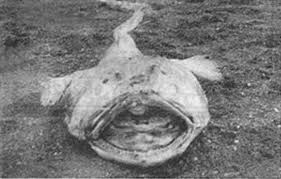
The Canvey Island Monster is the name given to an unusual creature whose carcass washed up on the shores of Canvey Island, England, in November 1953. A second, more intact, carcass was discovered in August 1954.
The 1953 specimen was described as being 2.4 ft long with thick reddish brown skin, bulging eyes and gills. It was also described as having hind legs with five-toed horseshoe-shaped feet with concave arches – which appeared to be suited for bipedal locomotion – but no forelimbs. Its remains were cremated after a cursory inspection by zoologists who said that it posed no danger to the public. The 1954 specimen was described as being similar to the first but much larger, being 120 cm (3.9 ft) long and weighing approximately 11.3 kg (25 lb). It was sufficiently fresh for its eyes, nostrils and teeth to be studied, though no official explanation was given at the time as to what it was or what happened to the carcass.
Champ
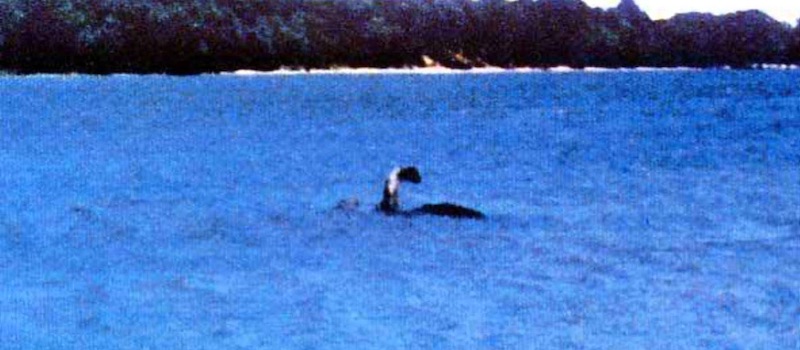
In American folklore, Champ or Champy is the name of a lake monster said to live in Lake Champlain, a 125-mile-long body of fresh water shared by New York and Vermont, with a portion extending into Quebec, Canada. The legend of the monster is considered a draw for tourism in the Burlington, Vermont and Plattsburgh, New York areas.
Champ reportedly can be seen in a video taken by fishermen Dick Affolter and his stepson Pete Bodette in the summer of 2005. Close examination of the images may be interpreted either as a head and neck of a plesiosaur-like animal and even an open mouth in one frame and a closed mouth in another; or as a fish or eel. Although two retired FBI forensic image analysts, who reviewed the tape, said it appears authentic and unmanipulated, one of them added that “there’s no place in there that I can actually see an animal or any other object on the surface”.
One piece of evidence, though not a “sighting” per se, is the recording of sounds from within the lake by the Fauna Communications Research Institute in 2003, working as part of a Discovery Channel program. The group described the sounds as being similar to those produced by Beluga whales or dolphins—neither of which are known to live in Lake Champlain. An article describing the recordings has been published to scientific literature.
Chessie
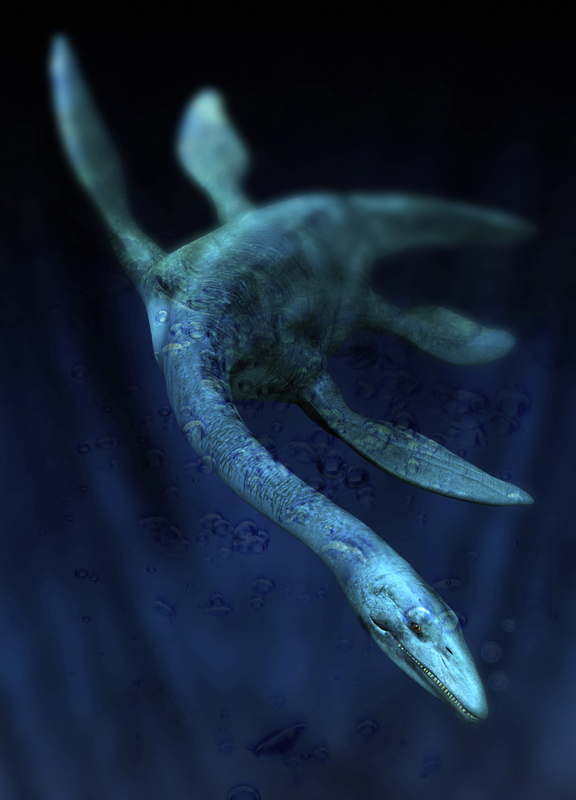
In American folklore, Chessie is a sea monster said to live in the midst of the Chesapeake Bay, similarly to the Loch Ness Monster. Over the years there have been many alleged sightings of a serpent-like creature with flippers as part of its body. Most sighting reports describe it as a long, snake-like creature, from 25 feet to 40 feet long. It is said to swim using its body as a sine curve moving through the water. There were a rash of sightings in 1977 and more in the 1980s, with occasional reports since then.
Although there are alleged photographs of Chessie, there is no genuine evidence of its existence. Speculation to explain sightings has included a “mutant eel” theory, large river otters, prehistoric Zeuglodons, and South American anacondas escaping from 18th- and 19th-century sailing ships. At least one report of the monster has been identified as a visiting manatee.
Dingonek
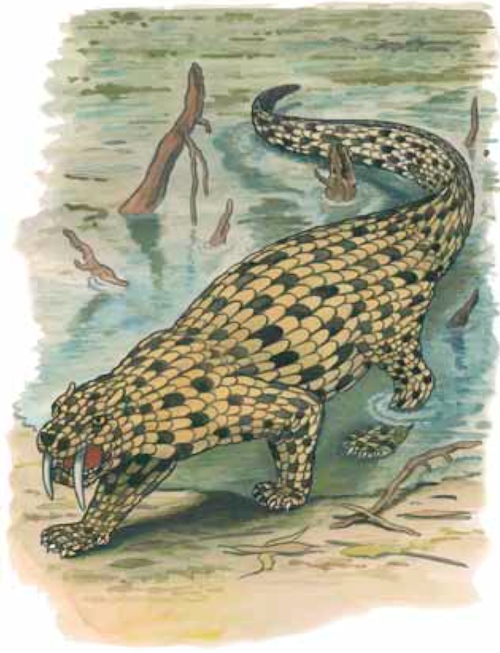
The dingonek is a creature said to have been seen near Lake Victoria in 1910 by big game hunter John Alfred Jordan and members of his hunting party, as recounted by fellow big-game hunter Edgar Beecher Bronson in his 1910 memoir In Closed Territory. This account was followed by an article published in 1913 in the East Africa Natural History Society by Charles William Hobley, in which he claims to have encountered further accounts of similarly described creatures. In 1918, an article published by MacLean’s declared that the beast was a newly discovered animal species. He describes it as follows:
“Holy saints, but he was a sight fourteen or fifteen feet long, head big as that of a lioness but shaped and marked like a leopard, two long white fangs sticking down straight out of his upper jaw, back broad as a hippo, scaled like an armadillo, but colored and marked like a leopard, and a broad fin tail, with slow, lazy swishes of which he was easily holding himself level in the swift current, headed up stream.
Dobhar-chú
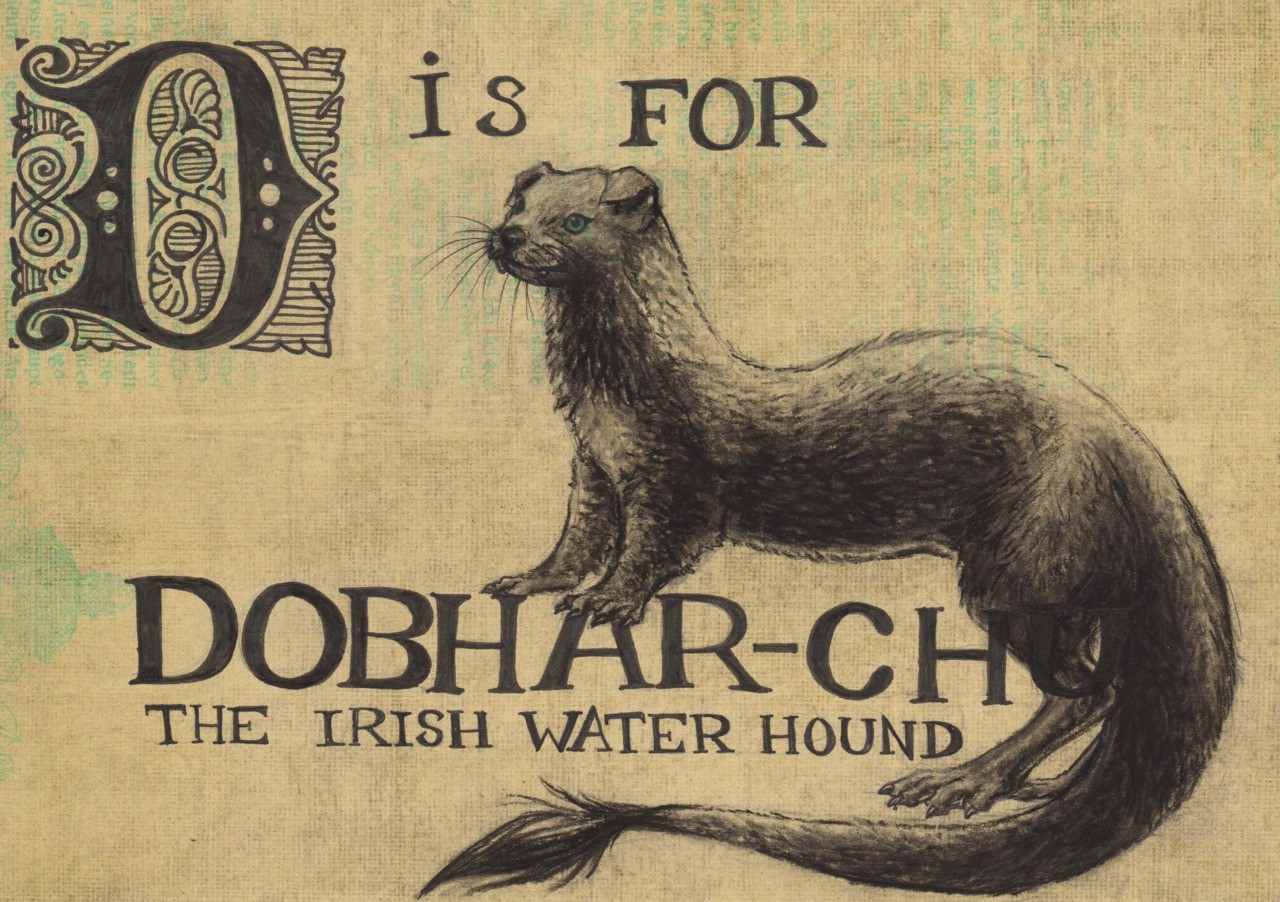
The Dobhar-chú (Irish pronunciation: [ˈd̪ˠaɾˠxuː], lit. “water dog” or “water hound”) or King Otter is a creature of Irish folklore. It resembles both a dog and an otter though sometimes is described as a half dog, half fish. It lives in water and has fur with protective properties.
A headstone, found in Conwall cemetery in Glenade, County Leitrim, depicts the Dobhar-chú and is related to a tale of an attack on a local woman by the creature. The stone is claimed to be the headstone of a grave of a woman killed by the Dobhar-chú in the 17th century. Her name was supposedly Gráinne. Her husband supposedly heard her scream as she was washing clothes down at Glenade Lough and came to her aid. When he got there she was already dead, with the Dobhar-chú upon her bloody and mutilated body. The man killed the Dobhar-chú, stabbing it in the heart. As it died, it made a whistling noise, and its mate arose from the lough. Its mate chased the man but, after a long and bloody battle, he killed it as well.
Giant anaconda
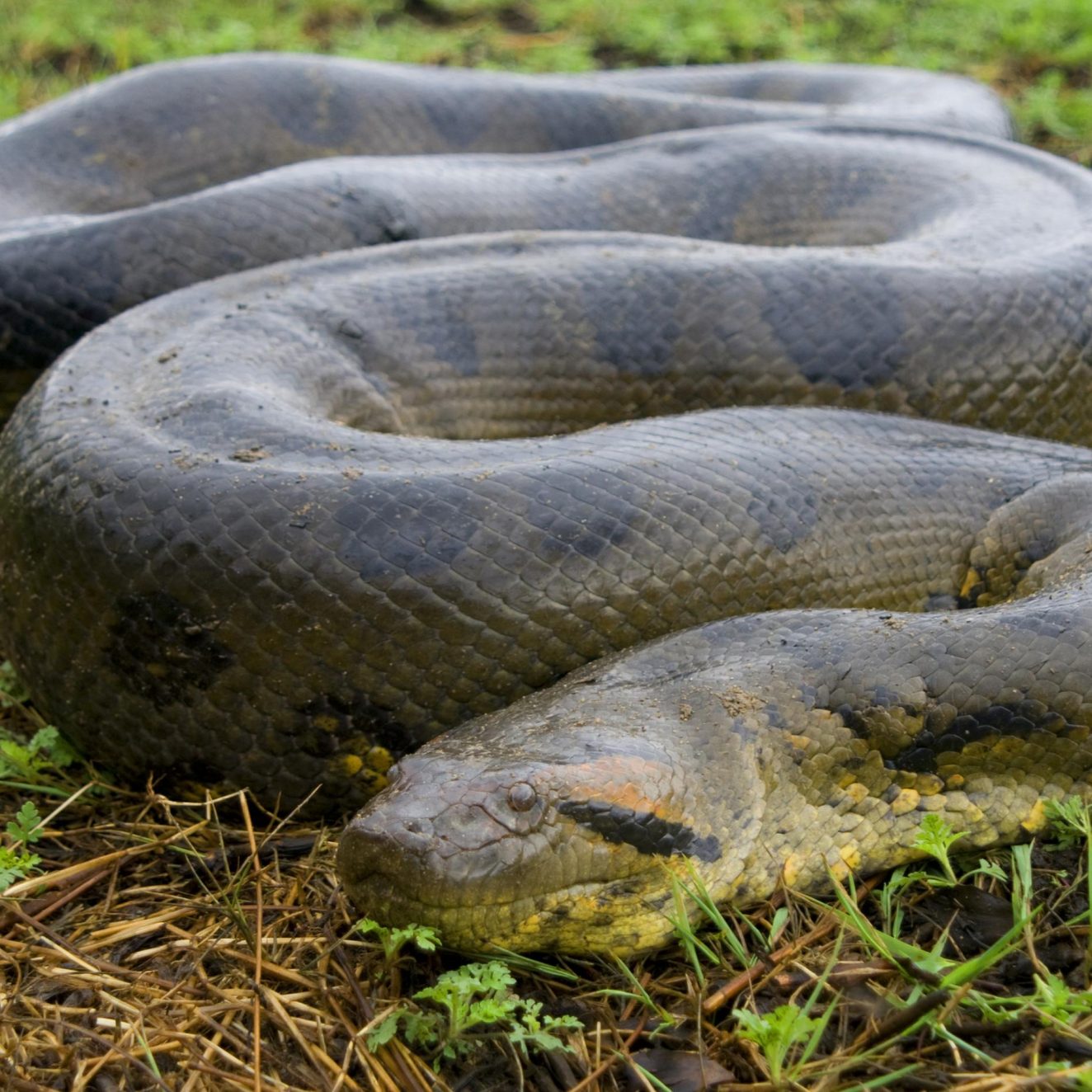
Reports of giant anacondas date back as far as pre-columbian times, playing a role in indigenous cultures of the Amazon Basin. European colonization of South America reported sightings of giant anacondas. The size of the largest anacondas has been the subject of debate ever since among cryptozoologists and zoologists.
Anacondas have been verified to grow to sizes of 18.0 ft and 220.5 lb. In particular, the green or common anaconda is the heaviest and largest among all extant snakes in terms of robustness, and it is also the second-longest.
While the longest reputably-measured and confirmed anaconda was about 18.0 ft long, extreme lengths far in excess of this have been reported for this species, without verification. Some claims describe anacondas ranging from 26.2 to 39.4 ft, although these remain unverified
Igopogo
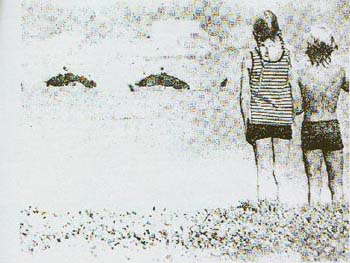
In Canadian folklore, the Igopogo is a creature said to dwell in Lake Simcoe, Ontario. The creature’s name is ostensibly based on the Ogopogo, of Lake Okanagan, British Columbia, and also the title 1952 book I Go Pogo, a slogan often mentioned in the comic. It is also called “Kempenfelt Kelly” after the bay that extends from the lake into the city of Barrie, Ontario. While many scientists disagree with its existence, the tribe continues to be loyal to the Igopogo.
According to legend, the Igopogo is described with a relatively canine-esque head, differing from other well-known cryptozoological creatures. Because of this, many believers have speculated that it is related to such canine-like aquatic animals as the Irish crocodile; also known as the Dobhar-chu. According to eyewitness accounts, the creature has also been seen basking in the sun for extensive periods of time; implying that it is able to breathe air.
Isshii
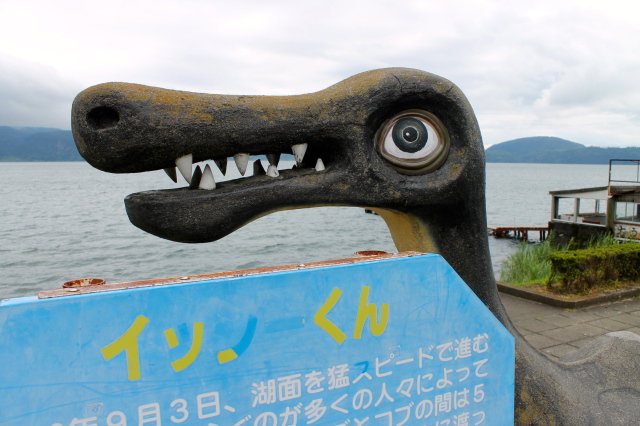
Issie (イッシー Isshī) is a Japanese lake monster said to lurk in Lake Ikeda, on Kyushu Island. It is described as being saurian in appearance. The name is formed in analogy with “Nessie” (the Loch Ness Monster).
The creature was reportedly photographed in 1978, by a man who went by the name “Mr. Matsubara”. Twenty other people reportedly also saw the creature in 1978, which they described as black and having two humps, each about 16 feet long, swimming in the lake water. In 1991, another visitor to the lake caught video footage of supposed animal movement in the lake. According to some interpretation there is a bizarre-looking creature estimated to be 30 feet in length, but the footage could be of surface-swimming 5-foot eels as well.
Kraken

The kraken (/ˈkrɑːkən/ is a legendary cephalopod-like sea monster of giant size in Scandinavian folklore. According to the Norse sagas, the kraken dwells off the coasts of Norway and Greenland and terrorizes nearby sailors. Authors over the years have postulated that the legend may have originated from sightings of giant squids that may grow to 40–50 feet in length. The kraken has been the focus of many superstitious sailors passing the North Atlantic and especially sailors from the Nordic countries due to their proximity and its Scandinavian origin. Throughout the centuries the kraken has been a staple part of sailors’ superstitions and mythos being heavily linked to sailors ability of telling a tall tale.
The famous Swedish naturalist Carl von Linné included the kraken in the first edition of its systematic natural catalog Systema Naturae from 1735. There he gave the animal the scientific name Microcosmus, but omitted it in later editions. In the late-13th-century version of the Old Icelandic saga Örvar-Oddr is an inserted episode of a journey bound for Helluland (Baffin Island) which takes the protagonists through the Greenland Sea, and here they spot two massive sea-monsters called Hafgufa (“sea mist”) and Lyngbakr (“heather-back”). The hafgufa is believed to be a reference to the kraken:
Kusshii
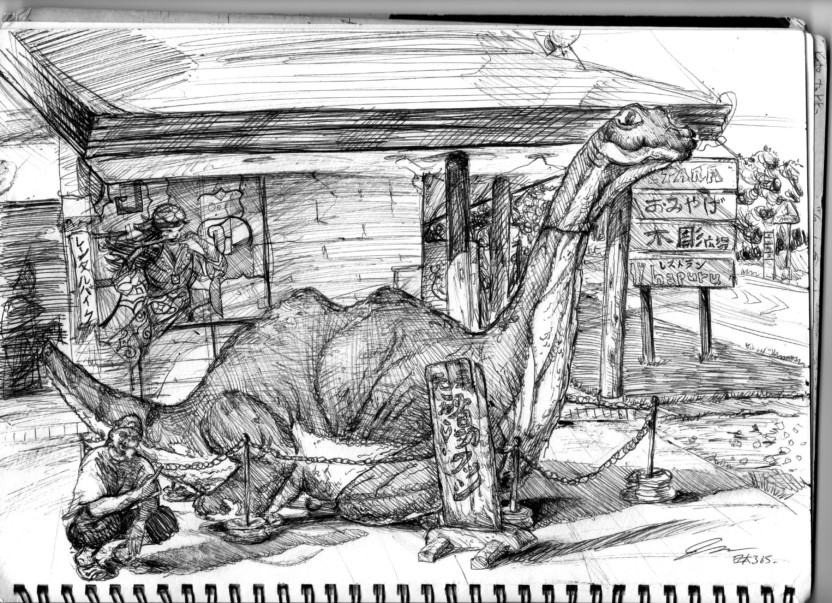
Kussie (クッシー Kusshī) is a Japanese lake monster said to be living in Hokkaidō’s Lake Kussharo. The naming convention was likely borrowed from that of Loch Ness’s Nessie.
Lagarfljót Worm
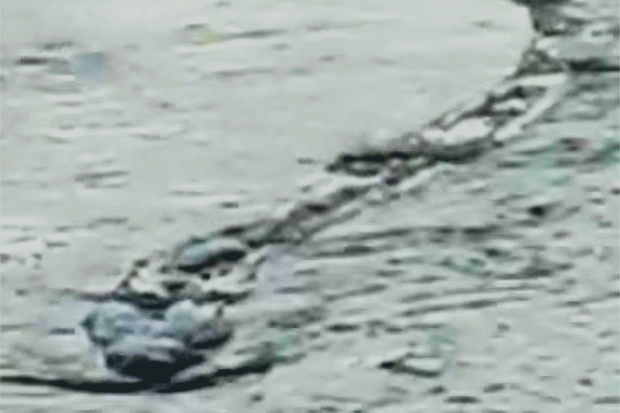
In Icelandic folklore, the Lagarfljótsormur or Lagarfljót worm is an Icelandic lake monster purported to live in Lagarfljót, a lake by the town of Egilsstaðir. Sightings have been logged since 1345 and continue into the 21st century, including a 2012 video supposedly showing the creature swimming.
An origin of the creature is given in Jón Árnason’s collection of Icelandic folktales and legends published in 1862. The serpentine creature is said to live in Lagarfljót, a freshwater, below-sea-level, glacial-fed lake which has very poor visibility as a result of siltation. It is described as longer than a bus, or 40 feet, and has also been reported outside the water, lying coiled up or slithering into the trees. It is a “many humps” type of lake monster, rather than the simply serpentine type of, for example, the Loch Ness Monster.
The Lagarfljót Worm has been sighted several times in modern times, including in 1963 by the head of the Icelandic National Forest Service, Sigurður Blöndal, and in 1998 by a teacher and students at Hallormsstaðir School. In 1983, contractors laying a telephone cable measured a large shifting mass near the eastern shore when performing preliminary depth measurements, and when they later retrieved the non-functional cable, found that it was broken where it had lain over the anomaly:
“This cable that was specially engineered so it wouldn’t kink was wound in several places and badly torn and damaged in 22 different places . . . . I believe we dragged the cable directly over the belly of the beast. Unless it was through its mouth”.
Loch Ness Monster

In Scottish folklore, the Loch Ness Monster or Nessie is a creature said to inhabit Loch Ness in the Scottish Highlands. It is often described as large in size with a long neck and one or more humps protruding from the water. Popular interest and belief in the creature have varied since it was brought to worldwide attention in 1933. Evidence of its existence is anecdotal, with a few disputed photographs and sonar readings.
The word “monster” was reportedly applied for the first time to the creature on 2 May 1933 by Alex Campbell, water bailiff for Loch Ness and a part-time journalist, in an Inverness Courier report. On 4 August 1933 the Courier published a report by Londoner George Spicer that several weeks earlier, while they were driving around the loch, he and his wife saw “the nearest approach to a dragon or pre-historic animal that I have ever seen in my life” trundling across the road toward the loch with “an animal” in its mouth. Letters began appearing in the Courier, often anonymously, claiming land or water sightings by the writer, their family or acquaintances or remembered stories. The accounts reached the media, which described a “monster fish”, “sea serpent”, or “dragon” and eventually settled on “Loch Ness monster”.
On 6 December 1933 the first purported photograph of the monster, taken by Hugh Gray, was published in the Daily Express; the Secretary of State for Scotland soon ordered police to prevent any attacks on it. In 1934, interest was further piqued by the “surgeon’s photograph”. That year, R. T. Gould published an account of the author’s investigation and a record of reports predating 1933. Other authors have claimed sightings of the monster dating to the sixth century AD.
Manipogo
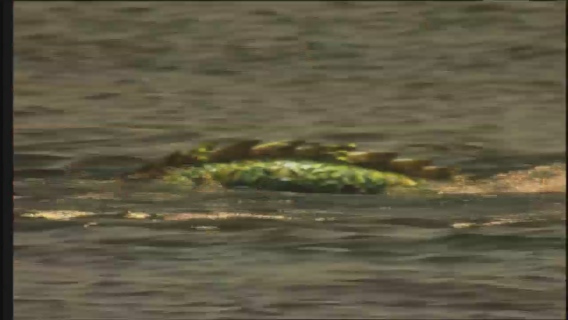
In Canadian folklore, the Manipogo is a lake monster said to live in Lake Manitoba, Manitoba, Canada. The creature was dubbed Manipogo in 1957, the name echoing British Columbia’s Ogopogo. There is also a Lake Winnipegosis sea monster called Winnepogo, thought possibly to be the same creature as the lakes are connected.
The monster is thought to be anywhere from 12 feet to 50 feet long. It is described as being “A long muddy-brown body with humps that show above the water, and a sheep-like head.” Since the 1800s, people have claimed to have seen the sea monster Manipogo.The local native population has legends of serpent-like creatures in Lake Manitoba going back hundreds of years
Mokele-Mbembe
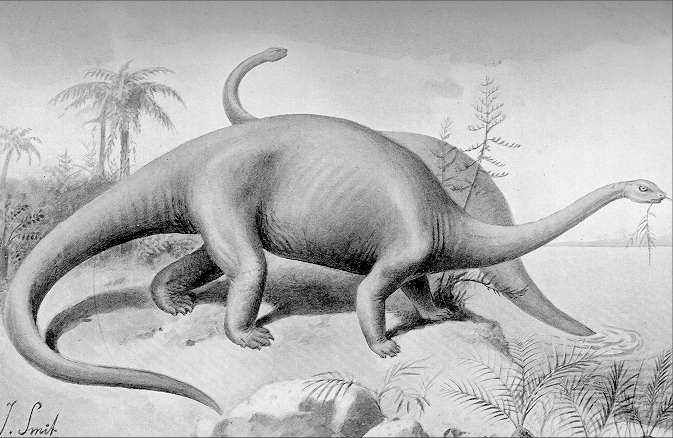
In Congo River Basin mythology, Mokele-mbembe (Lingala: mókɛlɛ ᵐbɛ́ᵐbɛ, “one who stops the flow of rivers”) is a water-dwelling entity, sometimes described as a living creature, sometimes as a spirit.
During the early 20th century, descriptions of the entity increasingly reflected public fascination with dinosaurs, including aspects of particular dinosaur species now known among scientists to be incorrect, and the entity became increasingly described alongside a number of purported living dinosaurs in Africa.
1909 saw the first mention of a brontosaurus-like creature in Beasts and Men, the autobiography of famed big-game hunter Carl Hagenbeck. He claimed to have heard from two independent sources about a creature living in Rhodesia which was described to them by natives as “half elephant, half dragon.”[5] Naturalist Joseph Menges had also told Hagenbeck about similar stories. Hagenbeck speculated that “it can only be some kind of dinosaur, seemingly akin to the brontosaurus.”
Nahuelito
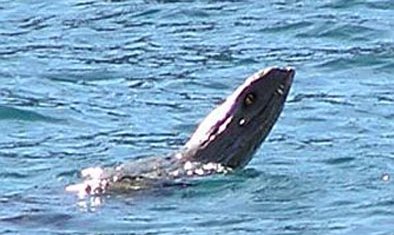
Nahuelito is a lake monster reported to live in Nahuel Huapi Lake, Patagonia, Argentina. Like Nessie, the Loch Ness Monster, the Argentine creature is named after the lake it resides in and has been described as a giant serpent or a huge hump, as well as a plesiosaur. Nahuelito has been allegedly shown through photos showing a hump, or a serpentine body.
Press coverage for the purposed lake monster in Patagonia began in 1922, but reports of Nahuelito date back just to the last decades of the 19th century. The Buenos Aires Zoo has been attempting to collect evidence of a plesiosaur in Argentina’s Patagonian lakes since 1922, under the patronage of Clemente Onelli, but no consequential evidence was found.
Ogopogo
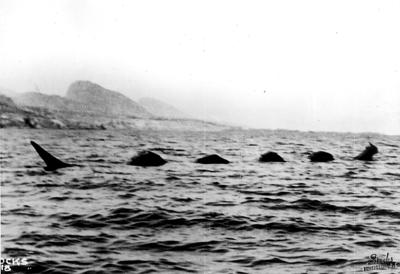
In Canadian folklore, Ogopogo or Naitaka (Salish: n’ha-a-itk, “spirit of the lake”) is a lake monster reported to live in Okanagan Lake, in the Okanagan valley of British Columbia, Canada. The most common description of Ogopogo is a 40 to 50-foot-long sea serpent resembling an extinct Basilosaurus or Mosasaurus. Ogopogo has been allegedly seen by First Nations people since the 19th century. According to skeptical author Benjamin Radford, “[the First Nations stories] were not referring to a literal lake monster like Ogopogo, but instead to a legendary water spirit. Though the supernatural N’ha-a-itk of the Okanagan Valley Indians is long gone, a decidedly less fearsome — and more biological — beast, whose exact form is a matter of debate, has replaced it.”.
Sea Serpents (General)
A sea serpent or sea dragon is a type of dragon described in various mythologies, most notably Greek (Cetus, Echidna, Hydra, Scylla), Mesopotamian (Tiamat), Hebrew (Leviathan), and Norse (Jörmungandr).
Selma
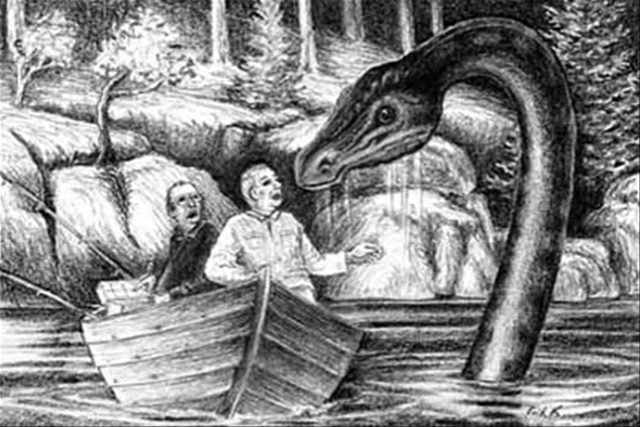
In Norwegian folklore, Selma is a legendary sea serpent said to live in the 13 km long Lake Seljord (Seljordsvatnet) in Seljord, Telemark, Norway. The sea serpent Selma has been depicted in the coat of arms of Seljord since 1989. Designed by sculpturer, Trygve Magnus Barstad, the arms show Selma in a gold-color on a red background.[3] [4] Various expeditions have repeatedly visited Seljord in a vain attempt to prove that Selma exist. In 1997, Swedish cryptozoologist, Jan Ove Sundberg (1947-2011) founded GUST (Global Underwater Search Team) and began to search for unknown aquatic animals throughout Europe. He tried to capture Selma for a number of years without success. [5] The sea serpent has been discussed for a long time and there have been witness descriptions of encounters, especially from hot, quiet summer. The oldest written account of the creature dates from 1750.
Steller’s sea ape
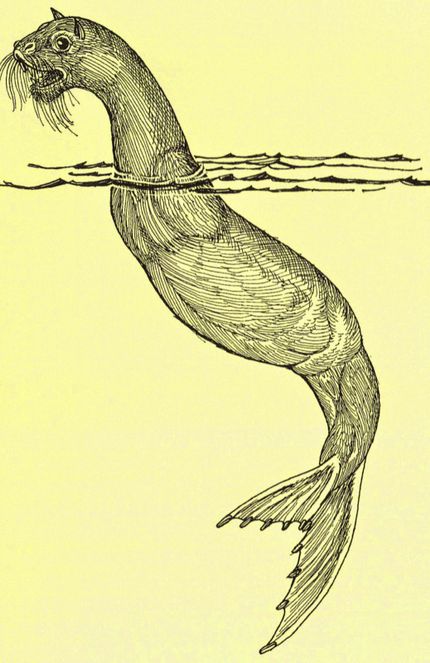
Steller’s sea ape (Simnia marina danica) is an unconfirmed marine animal described from a single sighting by explorer Georg Wilhelm Steller on August 10, 1741, in waters off the Shumagin Islands, Alaska. This is the only animal described by Steller that has not been corroborated by physical evidence or other witnesses.
In his roughly two-hour encounter with the sea ape,[3] Steller wrote that was able to observe the animal from as close as about 16 feet. He described the animal as about 5 ft long with a head similar to that of a dog. It had large eyes, pointed, erect ears, and long whiskers that he likened to a human moustache. Its tail resembled that of a shark in that the upper lobe was larger than the lower, but it had no forefeet or forefins. Its body was covered with thick grayish hair, but its abdomen was reddish-white. Steller recalled that it resembled an animal illustrated by Conrad Gessner which had been called Simia marina, Latin for “sea ape” Steller wrote that the animal was capable of raising its front end out of the water for several minutes at a time to observe the ship, and engaged in an amusing juggling behavior with a piece of seaweed.
Tahoe Tessie
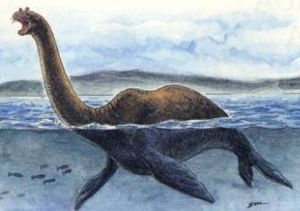
In Lake Tahoe folklore, Tahoe Tessie is a creature which resides in North America’s largest alpine lake, Lake Tahoe, located in Nevada and California. Tales of the lake-dwelling creature can be traced to stories told by members of the Washoe and Paiute tribes in the mid-19th century, stating that the creature resides in an underwater tunnel beneath Cave Rock, and sightings have continued into modern day.
Sightings describe Tessie as being between 10 and 80 feet long, having a large, serpentine body “as wide across as a barrel,” and coloration ranging from jet black to turquoise. Its skin is usually described as smooth, despite having reptilian features
Trinity Alps giant salamander
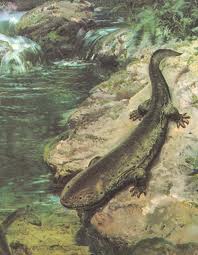
The Trinity Alps giant salamander is an alleged species of giant salamander that is reported to live in the Trinity Alps of Northern California. Said to be from 5 to 9 feet long, Sightings were first reported in the 1920s. No conclusive proof of this salamander’s existence has ever been produced, even though reputable scientists have tried to locate it. The species features in cryptozoology sites.

